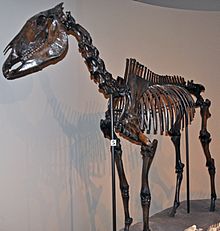Equus occidentalis (commonly known as the western horse) is an extinct species of wild horse that once inhabited North America, specifically the Southwestern United States, during the Pleistocene epoch.[1][2][3][4] It was first described from three teeth with insufficient diagnostic characters, one even being suggested to be a separate taxon related to the American Zebra, leading some researchers to consider it a nomen dubium, though this taxonomic debate is yet to be fully resolved.[5][6]
| Equus occidentalis Temporal range:
| |
|---|---|

| |
| Skeleton in Carnegie Museum of Natural History | |
| Scientific classification | |
| Domain: | Eukaryota |
| Kingdom: | Animalia |
| Phylum: | Chordata |
| Class: | Mammalia |
| Order: | Perissodactyla |
| Family: | Equidae |
| Genus: | Equus |
| Species: | †E. occidentalis
|
| Binomial name | |
| †Equus occidentalis Leidy, 1865
| |

E. occidentalis was about the same size as the modern Arabian horse, measuring up to 1.47 metres (4.8 ft) in shoulder height. It was morphologically and proportionally similar to the modern day zebra.[7]
References
edit- ^ Klide, A. M. (1989). "Overriding vertebral spinous processes in the extinct horse, Equus occidentalis". American Journal of Veterinary Research. 50 (4): 592–593. PMID 2712429.
- ^ Colbert, Edwin H. (1973). "Further Evidence concerning the Presence of Horse at Ventana Cave". Kiva. 39 (1): 25–33. doi:10.1080/00231940.1973.11757782. ISSN 0023-1940. JSTOR 30247142.
- ^ Kutcher, Maree Michelle; Scott, Eric (2016). "First Record of Equus occidentalis from Orange County, California, with Implications for the Late Pleistocene Distribution of Equus in the American Southwest". Geological Society of America Abstracts with Programs. Geological Society of America. doi:10.1130/abs/2016am-282407.
{{cite journal}}: Cite journal requires|journal=(help) - ^ "Equus occidentalis". www.utep.edu. Retrieved 2021-06-21.
- ^ Springer, K.; Scott, E.; Sagebiel, J.C.; Murray, L.K. (2010). "The Diamond Valley Lake local fauna: late Pleistocene vertebrates from inland southern California". 217 (1–2): 256–265. doi:10.1016/j.quaint.2009.10.041.
{{cite journal}}: Cite journal requires|journal=(help) - ^ Brown, K.E.; Akersten, W.A.; Scott, E. (2015). "Equus occidentalis Leidy from "Asphalto," Kern County, California". In Harris, J.M. (ed.). La Brea and Beyond: The Paleontology of Asphalt-Preserved Biotas. Los Angeles, California: Natural History Museum of Los Angeles County. pp. 81–89.
- ^ Willoughby, D.P. (1948). "A Statistical Study of the Metapodials of Equus occidentalis Leidy" (PDF). Bulletin of Southern Carolina Academy of Sciences. 47 (3): 84–94.
External links
editWikimedia Commons has media related to Equus occidentalis.